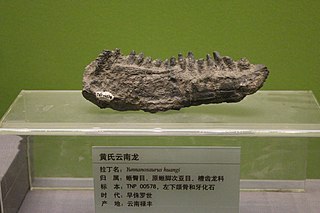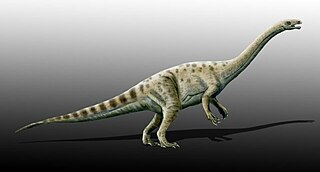Saturnalia is an extinct genus of basal sauropodomorph dinosaur known from the Late Triassic Santa Maria Formation of Rio Grande do Sul, southern Brazil and possibly the Pebbly Arkose Formation, Zimbabwe.

Massospondylus is a genus of sauropodomorph dinosaur from the Early Jurassic Period. It was described by Sir Richard Owen in 1854 from remains discovered in South Africa and Botswana, and is thus one of the first dinosaurs to have been named. Fossils have since been found at other locations in South Africa, Botswana, Lesotho, and Zimbabwe. Material from Arizona's Kayenta Formation, India, and Argentina has been assigned to this genus at various times, but the Arizonan and Argentinian material are now assigned to other genera.

Yunnanosaurus is an extinct genus of sauropodomorph dinosaur that lived approximately 201 to 168 million years ago in what is now the Yunnan Province, in China, for which it was named. Yunnanosaurus was a large sized, moderately-built, ground-dwelling, quadrupedal herbivore, that could also walk bipedally, and ranged in size from 7 meters (23 feet) long and 2 m (6.5 ft) high to 4 m (13 ft) high in the largest species.

Coloradisaurus is a genus of massospondylid sauropodomorph dinosaur. It lived during the Late Triassic period in what is now La Rioja Province, Argentina. It is known from two specimens collected from the Los Colorados Formation of the Ischigualasto-Villa Unión Basin.
Gryponyx is an extinct genus of massopod sauropodomorph known from southern Free State, central South Africa.

Massospondylidae is a family of early massopod dinosaurs that existed in Asia, Africa, North America, South America and Antarctica during the Late Triassic to the Early Jurassic periods. Several dinosaurs have been classified as massospondylids over the years. The largest cladistic analysis of early sauropodomorphs, which was presented by Apaldetti and colleagues in November 2011, found Adeopapposaurus, Coloradisaurus, Glacialisaurus, Massospondylus, Leyesaurus and Lufengosaurus to be massospondylids. This result supports many previous analyses that tested fewer taxa. However, this analysis found the two recently described North American massopods, Sarahsaurus and Seitaad, and the South African Ignavusaurus to nest outside Massospondylidae, as opposed to some provisional proposals. Earlier in 2011, Pradhania, a sauropodomorph from India, was tested for the first time in a large cladistic analysis and was found to be a relatively basal massospondylid. Mussaurus and Xixiposaurus may also be included within Massospondylidae. In 2019, a specimen previously assigned to Massospondylus from South Africa was re-examined and found to belong to a separate genus that was named Ngwevu.

Lamplughsaura is a genus of sauropodomorph dinosaur from the Sinemurian-age Dharmaram Formation of India, dating from between 196 and 190 million years ago. The type and only species is Lamplughsaura dharmaramensis. It is known from several partial skeletons of a large quadrupedal animal up to 10 meters (33 ft) long, and was either a basal sauropod or, less likely, a more basal sauropodomorph.

Glacialisaurus is a genus of massospondylid sauropodomorph dinosaur. It lived during the Early Jurassic period in what is now central Transantarctic Mountains of Antarctica. It is known from the holotype FMNH PR1823, a partial hind limb (foot) and from the referred material FMNH PR1822, a left femur. The size of the largest specimen (FMNHPR1822) has been estimated at 6.25 m (20.5 ft) and 590 kg (1,300 lb).

Plateosauria is a clade of sauropodomorph dinosaurs which lived during the Late Triassic to the Late Cretaceous. The name Plateosauria was first coined by Gustav Tornier in 1913. The name afterwards fell out of use until the 1980s.
The Nam Phong Formation, which correlates to the Indosinian III Unconformity, is a geological formation in Thailand. It underlies the Khorat Group. It consists of resistant, red-brown micaceous sandstones, conglomerates, siltstones and mudstones of mainly fluvial origin. The sandstones are medium to very fine-grained and are usually calcareous. The conglomerates contain pebbles of quartz, brown and grey chert, and reddish brown siltstone. Cross bedding and plane-bed stratification are common in the sandstones and conglomerates. The sandstones and conglomerates make up approximately 30% of the formation. This sedimentary rock formation is found in Khon Kaen Province, Thailand. It is of Norian to Rhaetian age to age, and is notable for its fossils of early dinosaurs.
The Upper Dharmaram Formation is an Early Jurassic geologic formation found in Andhra Pradesh, India. It is of Sinemurian age, and dinosaur remains are among the fossils that have been recovered from the formation.

Yizhousaurus is a genus of basal sauropodiform dinosaurs which existed in what is now Lufeng Formation, Yunnan Province of southern China during the lower Jurassic period. Identified from a nearly complete and exquisitely preserved skeleton, it is the most complete basal sauropod currently known with intact skull. Although its name was revealed in a 2010 Geological Society of America abstract by Sankar Chatterjee, T. Wang, S.G. Pan, Z. Dong, X.C. Wu, and Paul Upchurch, it wasn't validly named and described until 2018. The type species is Yizhousaurus sunae.
Nambalia is a genus of basal sauropodomorph dinosaur. It lived during the Late Triassic period in what is now Telangana, central India. It is known from the holotype ISI R273, parts 1–3, partially articulated postcranial material and from the paratypes ISI R273, parts 4-29, including partial postcrania of at least two individuals of different sizes found closely associated and one of them is nearly the same size as the holotype.
Jaklapallisaurus is a genus of unaysaurid sauropodomorph dinosaur. It lived during the Late Triassic period in what is now Telangana, central India. It is known from the holotype ISI R274, postcranial material which was collected from the Upper Maleri Formation of the Pranhita–Godavari Basin and from the referred material ISI R279, partially complete right femur which was collected from the Lower Dharmaram Formation. It was first named by Fernando E. Novas, Martin D. Ezcurra, Sankar Chatterjee and Tharavat S. Kutty in 2011 and the type species is Jaklapallisaurus asymmetrica. The generic name is derived from the Indian town of Jaklapalli which is close to the type locality. The specific name refers to the highly asymmetrical astragalus of this species in distal view. A cladistic analysis by Novas et al. found that all valid plateosaurid species form a large polytomy. Jaklapallisaurus was found along with the basal sauropodomorph Nambalia, a guaibasaurid, and two basal dinosauriforms.
The Pranhita–Godavari Basin is a northwest–southeast striking geological structural basin in eastern India. The basin contains up to 7 kilometres of sedimentary strata of late Carboniferous/Early Permian to Cretaceous age. The basin is 400 km in length with a width of about 100 km and is terminated by the coast of the Indian Ocean on the southeast end.
The Upper Maleri Formation is a sedimentary rock formation found in Telangana, India. It is one of the formations of the Pranhita–Godavari Basin. It is of late Norian and possibly earliest Rhaetian ages, and is notable for its fossils of early dinosaurs.
The Lower Maleri Formation is a sedimentary rock formation found in Andhra Pradesh and Telangana, India. It is the lowermost member of the Pranhita–Godavari Basin. It is of late Carnian to early Norian age, and is notable for its fossils of early dinosaurs, including the basal saurischian Alwalkeria.
The Lower Dharmaram Formation is a sedimentary rock formation found in Andhra Pradesh, India. It is one of the formations of the Pranhita–Godavari Basin. It is of latest Norian and Rhaetian ages, and is notable for its fossils of early dinosaurs.

Unaysauridae is a clade of basal sauropodomorphs from the Late Triassic of India and Brazil.





















